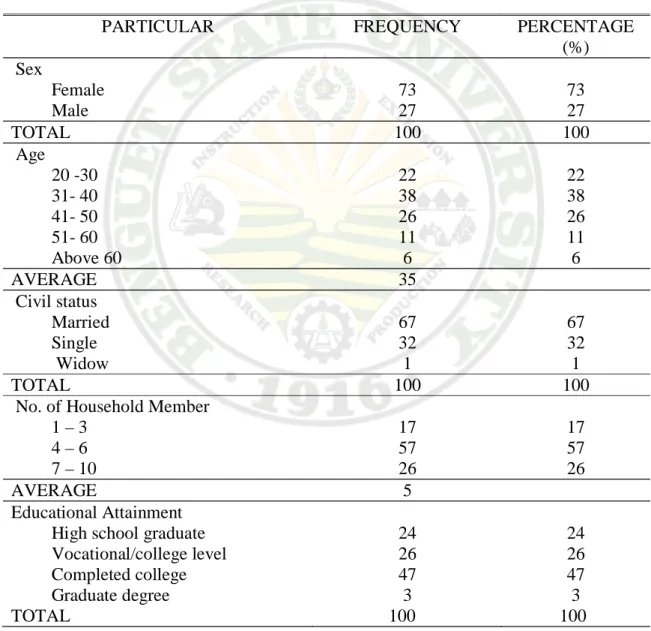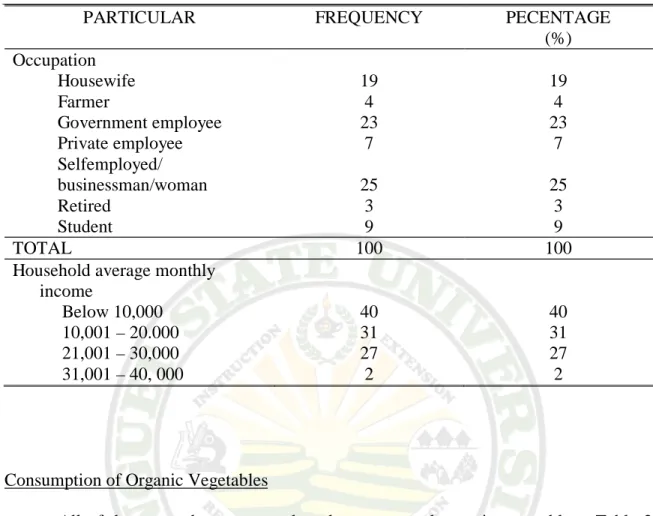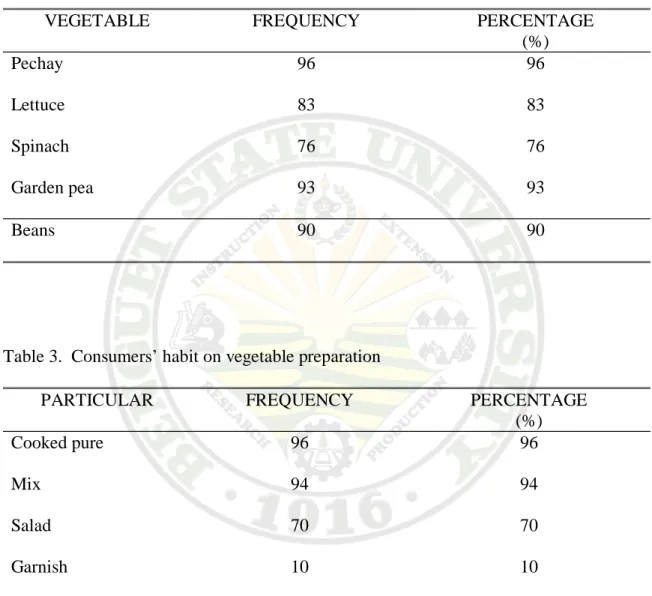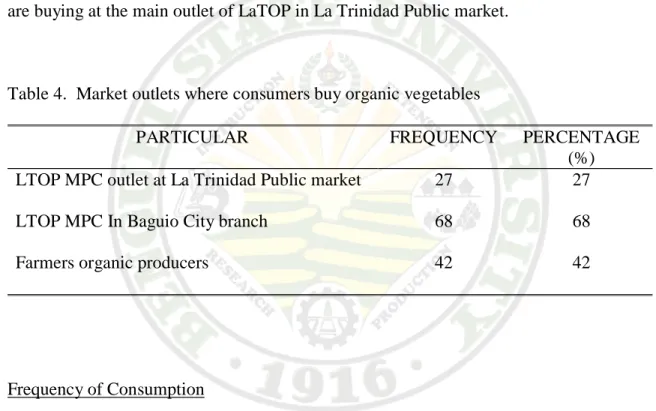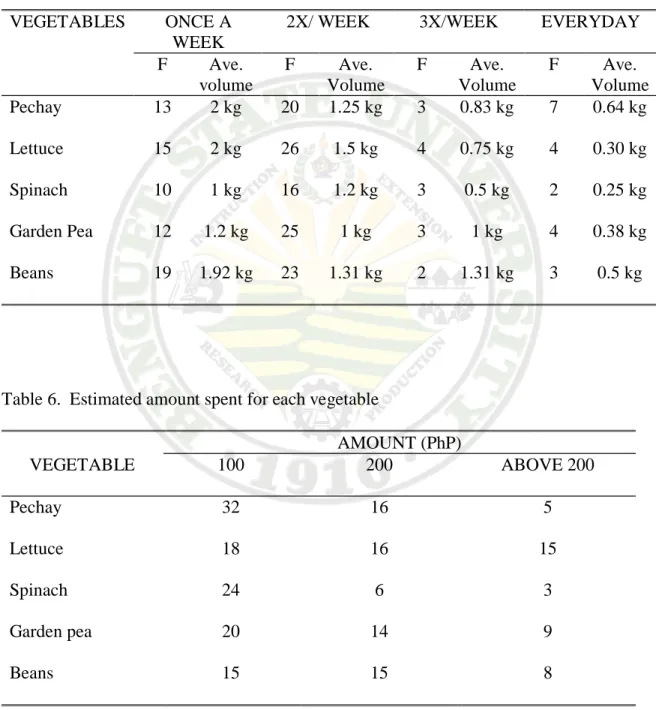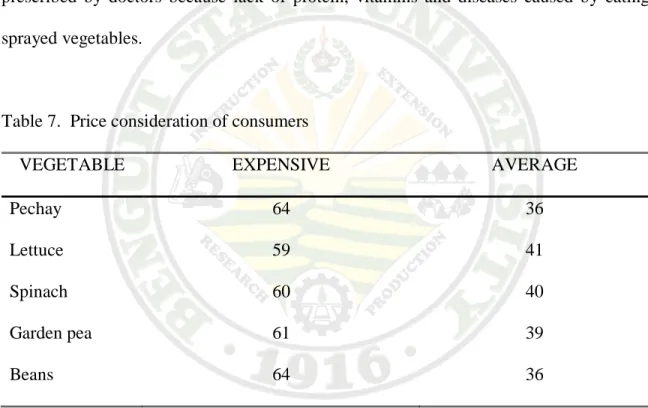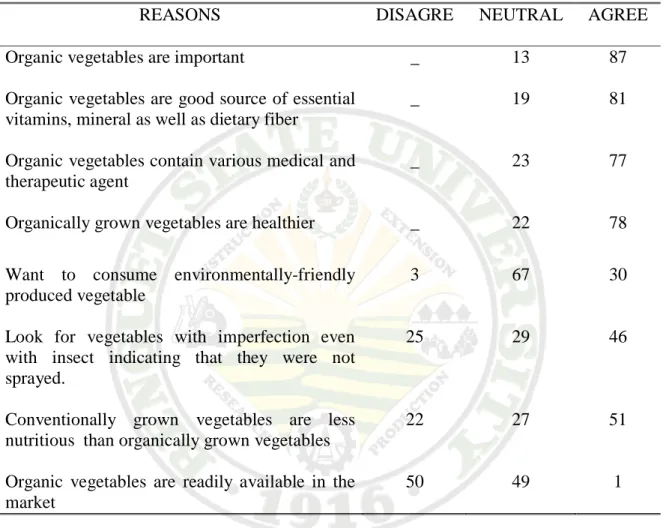BIBLIOGRAPHY
BOWAKEN, SALLY B. APRIL 2007. Household Consumption on Organic Vegetables in Baguio City.
Adviser: Jo Ann Guillao, BSc
Benguet State University, La Trinidad, Benguet.
ABSTRACT
The study was conducted to determine the household consumption of organic vegetables in Baguio City. It aimed to identify the most common purchased by vegetables, preparation of vegetables and the place of buying organic vegetables. It also determines the average purchase and the estimated amount spent for organic vegetables by consumer per time. Further it also aimed to know also the reasons of consuming and the quality attributes considered by consumers in purchasing organic vegetables.
Petchay is the most consumed vegetable by almost all of the respondents. Volume vegetables purchases showed that petchay and lettuce have the highest average volime when consumers buy every once a week.
All household members are consuming organic vegetables and they usually prepare those vegetables as their main dish. Most of them buy at (La Trinidad Organic Practitioner Multi Purpose Cooperative) LaTOPMPC, Baguio City branch and other market outlets that sell organic vegetables.
Organic vegetables are consumed by most households because they believe that these are good source of essential vitamins, minerals as well as dietary fiber. It contains various medical and therapeutic agent and they are healthy and nutritious food.
can not afford to pay high price of the product.
Pesticide free, color appearance and shelf life were the most important quality attributes considered by consumers in purchasing vegetables. Pesticide free was considered the most important attribute in buying organic vegetables to get rid of accumulating pesticide residue that may cause malfunction of the reproductive organ or other organs of the body.
The respondents suggested that farmers or producers of organic vegetables should increase market outlet of organic vegetables to cope with the consumption of households.
Government should intervene in the market by increasing incentive measures for the producers of organic vegetables and initiating promotional activities to inform the public of the good benefits of consuming organic vegetables. Producers or sellers of organic vegetables must also consider some creative and innovative way of handling vegetables to preserve their freshness and shelf life.
TABLE OF CONTENTS
Page
Bibliography……….. i
Abstract ………...………. i
Table of Contents ………. iii
INTRODUCTION. Rationale……….. 1
Statement of the Problem………. 2
Objectives of the Study………... 3
Importance of the Study……….. 3
REVIEW OF LITERATURE Concept of Organic Farming ……….. 4
Difference Between Conventional and Organic Production………... 5
Benefits of Consuming Organic Vegetables ……….. 5
Household Behavior on Consuming Organic Vegetables ……… 6
Significance of Producing Organic Vegetables ……….. 7
Promotion and Marketing of Organic Products ………. 8
Definition of Terms ……… 9
Locale and Time Study……….. 10
Respondents of the Study………... 10
Data Collection………... 10
Data Gathered………. 10
Data Analysis………. 11
RESULTS AND DISCUSSION Profile of the Respondents………. 12
Consumption of Organic Vegetables………. 14
Consumers Habit in Preparing Vegetables……….……… 14 Market Outlets Where Consumers Purchase organic vegetables………….……….. 15
Frequency of Consumption………... 16
Estimated Amount Spent per Vegetables………... 18
Price Consideration of Consumers………... 19
Importance of Price to the Respondents………... 19
Reason of Consumers in Consuming Organic vegetables………. 20 Quality Attributes of Vegetables………..……….. 20
SUMMARY, CONCLUSIONS AND RECOMMENDATIONS…………..…….. 23
Summary……… 23
Conclusions……… 24
Recommendations……….. 25
LITERATURE CITED……… 26
Whatever lifestyle we choose it is always a good choice to be healthy with our pure and organic food. Organically produced crops and other products have been proven to contain higher percentage of nutrient; have no pesticide residue generally taste better and have positive benefit on the environment. Organic fruits and vegetables are produced with the use of non-synthetic pest control that is quickly broken down by sunlight and oxygen, instead of long lasting synthetic chemicals. However, organic products carry chemical residues because of pesticides that are now pervasive in the ground water and rain, but of a lower percentage than conventionally grown products (Frank, 2006).
Benefits of eating organically grown vegetables are evident. Their greatest strength lie in minerals and vitamin content though many have appropriate percentage of dietary fiber, and practically have high water content. The nutritional values of organic vegetables are also good source of protein and minerals. It contain most of the elements needed for human diet in small and large quantities like vitamin C, K P (Pro vitamin A) and as well as B vitamins. In the case of organic vegetables grown in the Cordillera region, it was found out that the produce are not only tastier but have nutritional value higher than conventionally grown vegetable (Almonte, 2006).
Rationale
Compared with conventional farming, organic way of producing vegetables entails extensive use of labor, and use of natural fertilizer and pesticides. In this way, we could experience the good effect it could give to the people and the environment as enumerated by an organic farming practitioner in the person of Mr. Ambrosio Acosta.
Mr. Acosta owns and manages a garden in which he called “The Masters Garden”. He
2 also head the LaTOP cooperative in La Trinidad, Benguet, a cooperative institution that manifested organic farming. Among the benefits that could be derived from pricing organic farming are: preservation of the environment, minimize air water and oil pollution, care for the health of families communities and future generation and tending all organic garden with the soil and make him closer to nature.
With this foregoing statement, this study is therefore important as feedback mechanism on the situation of organic vegetables consumption in general and in Baguio City in particular. To be able to identify opportunities that will sustain the organic vegetable industry.
This study sought to answer the following questions:
Statement of the Problem
1. What are the organic vegetables consumed by households?
2. What are the reasons of household in consuming organic vegetables?
3. What are the qualities attributes of consumers in purchasing organic vegetables?
4. What is the volume of organic vegetables purchase per time by consumers?
5. What are the problems encountered by households in consuming/buying organic vegetables?
6. What are the suggestions/recommendations of consumers for the effective marketing strategy of organic vegetables?
The objectives of the study are the following:
Objectives of the Study:
1. Find out the organic vegetables consumed by the consumers.
2. Find out the reasons why households consume organic vegetables.
3. Determine the quality attributes of consumers in purchasing organic vegetables.
4. Determine the volume of organic vegetables purchase per time by the consumers.
5. Determine problems encountered by consumers in consuming organic vegetables.
6. Determine suggestions/recommendations of consumers for the effective marketing strategy of organic vegetables.
The study aims to determine the household consumption and purchase pattern of organic vegetables. To know the quality attributes considered by consumers in purchasing organic vegetables and their suggestion for effective marketing of this product.
Results of the study will serve as basis in planning for organic production by farmers and policy formulation and program on the part of government agencies; NGO’s who are supporting in promoting organic products. Results will be a guide and basis for further research endeavor on organic products.
Importance of the Study
REVIEW OF LITERATURE
Organic farming has been in existence since man began utilizing agricultural practices (Hall, 2002). Over the years organic method gave way to “conventional”
method characterized by the use of synthetic chemical inputs. Today however, there is renewal interest in organic farming and it is being termed by many alternatives methods of farming. These renewed interests are a direct result of high energy prices, increase in fertilizer cost, concern about health, and usage of environment-friendly usage of inputs in vegetable production.
Organic production takes into accounts for the minimum reliance on artificial inputs, feeding of soil and not the plants, food safety practices, non-use of hazardous chemical from far to distribution to marketing, certification of the entire production/distribution chain and not the end products, non-use of artificial growth enhancer in livestock and non-use of genetically-modified organisms. It also promotes biodiversity in the use of pesticides and chemical fertilizer is minimized if not avoided (Adonis et al , 2005).
Organic farming system avoids the use of the synthetic fertilizer and growth regulators. Instead they rely on crop rotation, crop residues, animal manures, legumes, green manures, off-farm wastes, mechanical cultivation, mineral bearing rocks and biological pest control to maintain soil health, supply plant nutrients, and minimize insect weeds and other pest (Sulliyan, 2006).
Concepts of Organic Farming
Organic farming according to Lampkin (1994) create integrated, humane, environmentally and economically sustainable agricultural production system which
maximize reliance on farm – derived renewable resources and the management of ecological and biological process and interaction so as to provide acceptable crop, livestock and human nutrition, protection from pest and diseases, and an appropriate return to human and other resources employed. Concerns of organic farming are; social concern over the loss of jobs and rural population decline, environmental concern over the loss of wildlife species and habitats, pollution and use of non renewable resources, health concern over pesticide residue and other food quality issues.
Difference Between Conventional and
Kim (2006), cited some differences between organic and conventional method of farming. In conventional farming, it makes use of commercially produced fertilizer, conventional farming for the first time is very progressive but because of continues use of the synthetic chemical the soil degraded and the production goes down. While in organic farming profit is preferably high because it doesn’t require high values farm inputs. Even though it has low and slow productivity but it sustains farm fertility but not deteriorated soil.
Organic Production
Consumers purchasing organically grown food can taste the difference and see the quality and virtually any organic products they buy. Regardless of minimal price differences, consumer buys organic food not just because of competitive prices, but due to the increased availability of organic food as seen in both grocery and organic food specialty stores. Organically grown products are free from harmful chemicals, artificial Benefits of Consuming Organic Vegetables
6 flavor and preservatives that ultimately cost consumer money when they purchase non- organically grown products. You can always taste the difference between organically grown and conventionally grown products. Eating organic foods may in fact reduce the risk of heart attacks, strokes and cancer for individuals who obtain from consuming products produced by conventional farming method. Biochemist are continually researching the inherent benefits of organically grown foods and discovering the consequences of consuming products loaded with toxins and chemicals which until recently have only begun to be introduced to human (Anonymous, 2003).
Household Behavior on Purchasing
Consumers are distinct on the characteristics of vegetables they purchase. They make sure that they are buying clean and safe to eat vegetables. Consumers look for imperfections even with insects indicating that they were not sprayed. They look for pesticide free vegetables to avoid accumulation of pesticide residues that cause the weakness and malfunction of organ of the body. Appearance is also important factor.
The absence of physical injuries and color like the dark green color of leafy vegetable like pechay indicate the freshness of vegetables. High price of organic vegetables/pesticide free are accepted if the farmers cooperative and other organization, even government do something to ensure that prices is affordable to the majority of consumers (Taguiling, 2001).
Organic Vegetables
Household is the basic purchasing and consumption unit for most consumer good.
Their purchasing behavior is mostly influenced by cultural, social, personal and psychological factors. Culture determines the wants of consumer s base on what the
people mostly buy eats and their belief. Social also affect because most group buy common good and it is the choice of friend or family members. Consumers are also influenced by personal characteristics which include occupation, age, educational status, personality and income. Rising of income affect the purchasing power of consumers.
They could afford to buy the expensive price of organic products. But a person buying choices are also influenced by major psychological factor, motivation, perception, learning, belief and attitude. A need becomes a motive when it arouse to sufficient level of intensity. A motive is a need if it sufficiently pressing to direct person to seek satisfaction.
The research office of Benguet State University in Benguet conducted various experiment on the use of organic and inorganic fertilizer in vegetables. Initially in 1993, cabbage and snap beans were used. The application of organic fertilizer during the first cropping season produced the highest yield. However, pure organic fertilizer produced a comparable yield. For the result of snap beans, the organic fertilizer produced higher yield over the control while, the inorganic produce the highest yield. The subsequent study used sweet pea and potato. Organic fertilizer significantly increased the yield of sweet pea over the inorganic fertilizer but not in potato. Pure inorganic fertilizer produced the highest yield in potato (Barrozo, 2006).
Significance of Producing Organic Vegetables
According to dela Cruz (2004), crops that were applied with organic fertilizer performed better compared to those crops that were grown with commercial fertilizer.
The slow release of nutrients from the animal manure minimizes the nutrients losses in
8 the soil resulting to the efficient nutrients uptake of crops that leads to higher yields.
Organic farming also serves as a valuable conditioner of soil retaining humidity and improving structure and internal drainage.
Organic foods are produced by farmers who emphasize the use of renewable research and the conservation of soil and water to enhance environmental quality future generation. Organic vegetables are produced without using the most controversial pesticides petroleum-based fertilizer, or sewage sludge-based fertilizer, bio engineering or ionizing radiation. Organic system replenishes and maintains soil fertility, eliminate the use of toxic and persistent pesticides and fertilizer, and build biologically diverse agriculture.
Organic farming, Layese (2006), said that it is an agricultural production system that promotes environmentally, socially, and economically sound production of fruits and vegetables that exclude the use of synthetically compound fertilizer, pesticides, growth regulator, feeds and additives in livestock and genetically modified organism.
Organic agriculture is seen in one way of creating market of consumers who demand for health and are conscious of their environment. Efforts are being done by groups, by government and private agencies to promote organic farming.
Promotion and Marketing of Organic Products
In the developed countries, increasing awareness of the harmful effect of foods produced with high chemical inputs has created a demand for organic product. But organic products are expensive because it is clear that, conventional farming is subsidized worldwide by protection of credit while organic farming is not, so its price is reflected on
the laborious way of farming. The local producer of these producers do not know where to sell it but in (1977) as acknowledged by Kenmore that there are becoming more and more consumers prepared to pay higher price for organic products.
Definition of Terms
Organic vegetables. These are produced by organic farmers who avoids or largely excludes the use of synthetically produced fertilizers, pesticides and growth regulators. It relies on crop rotation, crop residues, animal manures, legumes, green manures, off farm organic waste and aspect of biological control.
Perception. Refers to the reason s why people purchase/consume organically grown vegetables.
Household. It refers to person staying in one roof, sharing common source of income and with a common kitchen
Traditional production of fertilizers. This is synonymous to organic vegetable that help on the promotion of environmentally-friendly produced vegetables.
Conventional production of vegetables. It refers to framing system dependent on the input of artificial fertilizer and pesticides.
METHODOLOGY
This study was conducted in Baguio City from January to February, 2007.
Baguio City is one of the market centers of agricultural products of the Cordillera Region. The map of Baguio City is shown in Figure 1.
Locale and Time of the Study
There were 100 respondents of the study. Respondents were household consumers of vegetables residing in the City of Baguio. Random sampling was employed in the selection of respondents.
Respondents of the Study
Data Collection
A survey questionnaire was used in gathering data needed in the study. This was supported with an interview to the respondents to validate data gathered.
Data Gathered
The study gathered in the study was consumption pattern on organic vegetables by households. The quality attributes of consumers in purchasing organic vegetables and the suggestion of respondents for effective marketing of organic vegetables were also gathered.
The data gathered were tabulated and analyzed using simple statistical tools such as descriptive analysis, frequency counts, mean and percentages.
Data Analysis
RESULTS AND DISCUSSION
Profile of the Respondents
Table 1 shows the data on sex, age, civil status, number of household members, educational attainment, occupation and monthly income of the respondents.
Sex. Majority (73%) of the respondents were females and 27% were males.
Age. Age of the respondents ranges from 20 to more than 60 years old. The highest percentage (38%) of the respondents were 31 – 40 years old. The average age was 35 years old.
Civil status. Most (67%) of the respondents were married, 38% were single and only 1% was a widow.
Number of household members. Most of the respondents were staying with the family. Number of household members ranges from 1 to 10 members. More than half of the respondents have 4-6 family members and average household. The average household members was 5.
Educational attainment. As shown in the table all the respondents have attended formal education, 47% were college graduate, 26% had finished a vocational course and had reached college level, 24% were high school graduate and 3% had finished a graduate degree.
Occupation. Occupation of respondents represent a variety of jobs, 25% were self employed, businessman or business woman, 23% were employed full time and 19% were plain housewife. Nine percent (9%) of the respondents were students, 7% were employed- part time and the others were farmers and retirees.
Household average monthly income. Forty (40%) of the respondents have an average income of less than Php. 10,000 a month, 31 or 31 % of the respondents have an average income ranging from 10,001-20,000 pesos per moth and 27 or 27% have an average income of Php 21,001 – 30,000 per month and 2 (2%) have an average monthly income of Php 31,000 – 40,000.
Table 1. Profile of the respondents
PARTICULAR FREQUENCY PERCENTAGE
(%) Sex
Female 73 73
Male 27 27
TOTAL 100 100
Age
20 -30 22 22
31- 40 38 38
41- 50 26 26
51- 60 11 11
Above 60 6 6
AVERAGE 35
Civil status
Married 67 67
Single 32 32
Widow 1 1
TOTAL 100 100
No. of Household Member
1 – 3 17 17
4 – 6 57 57
7 – 10 26 26
AVERAGE 5
Educational Attainment
High school graduate 24 24
Vocational/college level 26 26
Completed college 47 47
Graduate degree 3 3
TOTAL 100 100
14 Table 1…continued
PARTICULAR FREQUENCY PECENTAGE
(%) Occupation
Housewife 19 19
Farmer 4 4
Government employee 23 23
Private employee 7 7
Selfemployed/
businessman/woman 25 25
Retired 3 3
Student 9 9
TOTAL 100 100
Household average monthly income
Below 10,000 40 40
10,001 – 20.000 31 31
21,001 – 30,000 27 27
31,001 – 40, 000 2 2
Consumption of Organic Vegetables
All of the respondents are purchased or consumed organic vegetables. Table 2 shows that pechay (96%) was the most common vegetable purchased/consumed by the consumers which was followed by garden pea (93%), beans (90%), lettuce (83%) and spinach (76%). There were also other vegetables that were stated by the consumers like broccoli, sayote, mustard, watercress, cabbage, potato and carrots.
Consumers Habit on Vegetable Preparation
All household members of the respondents are consuming organic vegetable.
Table 3 shows the consumers habits on preparation of vegetable. Most of the respondents (96%) cook the vegetables pure, 94% use it as mixing ingredient on fish,
meat and other vegetables, 70% prepare salad out of vegetables and 10% use it for garnish.
Table 2. Common organic vegetables purchase/consume by respondents
VEGETABLE FREQUENCY PERCENTAGE
(%)
Pechay 96 96
Lettuce 83 83
Spinach 76 76
Garden pea 93 93
Beans 90 90
Table 3. Consumers’ habit on vegetable preparation
PARTICULAR FREQUENCY PERCENTAGE
(%)
Cooked pure 96 96
Mix 94 94
Salad 70 70
Garnish 10 10
Market outlets where consumers purchase organic vegetables
Table 4 shows the market outlets of buying organic vegetables. Out of the 100 respondents 68% purchased at La Trinidad Organic Practitioners Multipurpose
16 Cooperative (LaTOP, MPC) branch in Baguio City. There were two outlets of organic vegetables in Baguio City, one is found at Bokawkan Road near the “Umali Kayo” café and the other one is found at Marius near the Victory Line Station at PNR. The market day of organic vegetables in Baguio opens only during Wednesday and Saturday, and the respondents are suggesting that producers should market their products regularly. This shows that the residents of Baguio City are really willing or prefer buying organic vegetables, 42% are buying directly from the farmers who are organic producers and 27%
are buying at the main outlet of LaTOP in La Trinidad Public market.
Table 4. Market outlets where consumers buy organic vegetables
PARTICULAR FREQUENCY PERCENTAGE
(%) LTOP MPC outlet at La Trinidad Public market 27 27
LTOP MPC In Baguio City branch 68 68
Farmers organic producers 42 42
Frequency of Consumption
Table 5 shows the frequency and average volume purchase per time by the respondents. The table shows that most of the respondents purchase vegetables twice a week. Beans were most purchase once a week, lettuce in twice a week, lettuce in thrice a week and pechay everyday.
Pechay. There are 13 respondents who buy once a week with and average of 2 kg purchase per time. 20 respondents buy twice a week with 1.25 kg per time, 3 respondents
purchased 3 times a week with an average volume of 0.83 kg purchased per time. Seven respondents purchase everyday with an average volume of 0.64 Kg per day for pechay.
Lettuce. There were 15 respondents who buy once a week with 2 kg average volume purchased per time, 26 respondents buy twice a week a week with 1.5 kg purchased per time, 4 respondents purchased 3 times a week with an average volume of 0.75 kg purchased per time 4 respondents buy every week with an average volume of 0.3 kg purchased per time.
Spinach. There were 10 respondents who buy once a week with 1 kg average per time, 16 respondents buy twice a week with 1.2 kg average volume purchased per time, 3 respondents buy thrice a week with 0.5 kg purchased per time and 2 respondents buy everyday with 0.25 kg per time.
Garden pea. There were 12 respondents who buy once a week with an average of 1.92 kg purchased per time. 25 respondents purchase twice a week with an average volume of 1.1 kg per time, 3 respondents buy 3 times a week with an average volume of 1 kg per time, and 4 respondents buy everyday with an average volume of 0.38 Kg per day.
Beans. There were 19 respondents who buy once a week with 1.92 kg purchased per time, 23 respondents buy 2 times a week with an average volume of 1.31 kg purchased per time, 2 respondents buy 3 times a week with a kg average volume purchased per time and 3 respondents buy everyday with 0.5 kg average volume purchased per time.
18 Estimated Amount per Vegetables
The table 6 shows that most of the respondents spent 100 pesos in purchasing organic vegetables.
Table 5. Frequency and average volume of vegetables purchased per time VEGETABLES ONCE A
WEEK
2X/ WEEK 3X/WEEK EVERYDAY
F Ave.
volume
F Ave.
Volume
F Ave.
Volume
F Ave.
Volume Pechay 13 2 kg 20 1.25 kg 3 0.83 kg 7 0.64 kg Lettuce 15 2 kg 26 1.5 kg 4 0.75 kg 4 0.30 kg
Spinach 10 1 kg 16 1.2 kg 3 0.5 kg 2 0.25 kg
Garden Pea 12 1.2 kg 25 1 kg 3 1 kg 4 0.38 kg Beans 19 1.92 kg 23 1.31 kg 2 1.31 kg 3 0.5 kg
Table 6. Estimated amount spent for each vegetable
AMOUNT (PhP)
VEGETABLE 100 200 ABOVE 200
Pechay 32 16 5
Lettuce 18 16 15
Spinach 24 6 3
Garden pea 20 14 9
Beans 15 15 8
Price Consideration of Consumers
Table 7 shows the consideration of price by respondents. Price consideration was categorized cheap, average and expensive. Most of the respondents consider the price of vegetable is expensive because they don’t have enough money to spare. Less than half of the respondents consider it average. The price of organic vegetables is worth for them to pay because they are produced environmentally friendly. Organic vegetables are healthy and nutritious food. The high price of organic product is better than buying medicine prescribed by doctors because lack of protein, vitamins and diseases caused by eating sprayed vegetables.
Table 7. Price consideration of consumers
VEGETABLE EXPENSIVE AVERAGE
Pechay 64 36
Lettuce 59 41
Spinach 60 40
Garden pea 61 39
Beans 64 36
Importance of Prices to the Respondents
Table 8 shows that most of the respondents (64%) considered that a price of vegetables is not important in the decision to purchase vegetables and 26% mentioned it is important.
20 Table 8. Importance of prices
PARTICULAR FREQUENCY PERCENTAGE
(%)
Not important 64 64
Important 26 26
TOTAL 100 100
Reasons of Consuming Organic Vegetables
Table 9 shows the reasons of respondents in consuming organic vegetables. Out of the 100 respondents (87%) agreed that vegetables were important in the daily diet, 81% considered organic vegetables were essential sources of vitamins and mineral, 77%
considered organic vegetables contain various medical and therapeutic agent, and 78%
believed that organically grown vegetables are healthy foods.
Quality Attributes of Vegetables
Among the 10 quality attribute of purchasing organic vegetables Table 10 shows the top 3 attributes considered by households in purchasing organic vegetables. Pesticide free, color, appearance were the top 3 most important in purchasing petchay, lettuce and garden pea. While in purchasing spinach and beans pesticide free, color and shelf life were considered by household as important quality attributes.
Among the 10 quality attributes, Table 11 shows the least important considered by households in purchasing organic vegetables. The size, shape and firmness were marked by respondents as least important attributes in purchasing pechay and garden pea.
Size, shape and variety were also marked as least important in purchasing spinach and beans. While in purchasing lettuce size, shape and origin were marked least important.
Table 9. Reasons of consumers in consuming vegetables
REASONS DISAGRE NEUTRAL AGREE
Organic vegetables are important _ 13 87
Organic vegetables are good source of essential vitamins, mineral as well as dietary fiber
_ 19 81
Organic vegetables contain various medical and therapeutic agent
_ 23 77
Organically grown vegetables are healthier _ 22 78 Want to consume environmentally-friendly
produced vegetable
3 67 30
Look for vegetables with imperfection even with insect indicating that they were not sprayed.
25 29 46
Conventionally grown vegetables are less nutritious than organically grown vegetables
22 27 51
Organic vegetables are readily available in the market
50 49 1
Table 10. The most considered quality attributes in purchasing organic vegetables QUALITY
ATTRIBUTES
PETCHAY LETTUCE SPINACH GARDEN PEA
BEANS Pesticide free X X X X X Color X X X X X Appearance X X X
Shelf life X X
22 Table 11. The least considered qualities attribute in purchasing organic vegetable
QUALITY ATTRIBUTES
PETCHAY LETTUCE SPINACH GARDEN PEA
BEANS Size X X X X X Shape X X X X X
Variety X X
Origin X
firmness X X
The study was conducted to determine the household consumption of organic vegetables by selected respondents of Baguio City. It aimed to identify consumed/purchased organic vegetables by the households, how the vegetables were prepared, and where do consumers buy organic vegetables. It also aimed to know the total purchases, estimated amount spent, reasons why they purchase organic vegetables and the attributes of organic vegetables commonly considered by consumers.
There were 100 respondents who were selected randomly. Data were gathered through a survey questionnaire.
Pechay is the most consumed vegetables by almost all the respondents followed by garden pea, beans lettuce and spinach. Beans is most purchased every week, lettuce is twice a week and pechay is purchased everyday. Pechay and lettuce with 2kg has the highest average volume purchase in once a week, lettuce with 1.5kg has the highest average volume purchase twice week, beans with 1.31kg has the highest average volume purchase in thrice a week and pechay with 0.64kg has the highest average volume purchase everyday per respondents. Most of the respondents spend 100 pesos for organic vegetables per time of purchase.
All the household members are consuming organic vegetables that they usually cooked the vegetable pure for consumption. Most of them buy at the LaTOP branch in Baguio City. This shows that residents of Baguio City are consuming organic vegetables.
Summary
Most respondents consider the price very expensive because they don’t have enough money to buy organic vegetables. Others consider that the price is just average
24 because they believe that organic vegetables are healthy and nutritious food. The high price is acceptable to them because they are sure that the vegetables are pesticide free Most of the respondents agree that vegetables are important part of our daily diet, organic vegetables are good source of essential vitamins and minerals as well as dietary fiber, organic vegetables contain various medical and therapeutic agent and they believe that organically grown vegetables are healthier. Consumer look for vegetables with imperfection even with insect indicating that they were not sprayed and conventionally produced vegetables are less safe to consume than organically grown vegetables. Half of the respondents disagree that organic product are readily available in the market.
Most of the respondents marked pesticide free as the most important quality attributes consider in purchasing organic vegetables. This is followed by color, appearance, price shelf life are most important quality attributes also. Size, shape, variety, origin and firmness are less important. But size is considered the least important among the 10 characteristics of vegetables.
Based on the results, the following conclusions were made:
Conclusions
1. Most of the household members are consuming organic vegetables and buy them from different outlets but especially from La TOP branch outlet in Baguio City.
Pechay is the most common purchased/consumed by the respondents. They prepare vegetables by cooking it as their main dish.
2. Pechay is most purchased once a week and other vegetables twice or thrice a week. Respondents spent about Php.100 in purchasing organic vegetables.
3. Respondents consider organic vegetables as important in our daily diet because it more nutritious and healthier and a good source of essential vitamins and minerals than other food.
4. Pesticide free, color, appearance and shelf life were very important consideration in purchasing organic vegetables. Firmness and origin, variety, shape and size were considered least important attributes in purchasing organic vegetables.
Based on the , the following recommendations are made:
Recommendations
1. Farmers or producers should try to increase market outlet for organic vegetables to cope with the consumption of households.
2. Government agencies should try to intervene in the market by increasing incentive measure for producers of organic vegetables and by initiating promotional activities to inform to the public the benefits of consuming organic vegetables, thereby affecting their consumption of organic vegetables.
3. Producer’s sellers of organic vegetables must also consider some creative and innovative way of handling vegetables to preserve freshness and shelf life of organic vegetables.
LITERATURE CITED
ANONYMOUS, 2003, Organic farming. Retrieved September 2, 2006 from
ADONIS, D. L. et. al. 2005 Organic Farming Experience; The Case of Samuel Cabansi, Experience in Agriculture Production in Benguet, Benguet State University, La Trinidad Benguet.
ALMONTE, P.B. 2006, Basic Standard for Organic Agriculture and Processing Paper Presented During the Cordillera Agriculture Congress held at Benguet State University, La Trinidad Benguet.
BARROZO, R.J. 2006. Organic Standard and Organization; Paper Presented during the first Cordillera Organic Agriculture Congress held at Benguet State university, La Trinidad, Benguet 2006.
DE LA CRUZ, R.T. 2004. Growing Vegetables Organically. BAR Research and Development Digest. Bureau of Agricultural Research Department of Agriculture. Pp1-2,9
FRANK, S. 2006. The Green Living Source for Today’s Conscious Consumer.
Retrieved September 5, 2006 from http://www/.thegreen.guide.com./organic products.
HALL, S. 2002. A Guide to Marketing Organic Product; Paper Presented During the Public Consultation on Organic Agriculture Standard held at Hotel Supreme, 133 Magsaysay Street. Baguio City
KENMORE, P.E. 1995. Agriculture and Rural Development.
KIM, A.K. 2006. Natural Farming Technology Seminar, BPI- BNRDC Baguio City 2600, 2006
LAMPKIN, P.E. 1994. The Economics of Agriculture Farming, An International Perspective. Department of Agricultural Science, University of Wales Abersytwyth U.K. Lab International.1994
LAYESE G.F. 2006. Status of Organic Agriculture in the Philippines; Paper Presented During the Cordillera Organic Agriculture Congress held Benguet State University, La Trinidad Benguet, March 2006.
LUGANG- A, B.M. 2006. Vegetable purchase and consumption pattern of Household in Baguio City. BS Thesis, Benguet State University, La Trinidad, Benguet.
2006
SULLIYAN, P. 2003. Organic Rice Production. Retrieved September 4, 2006 from http://ww:attrq.org/attrapub/rice.htm.
TAGUILING, S. 2001. Consumers awareness on IPM vegetables. BS Thesis.
Benguet State University, La Trinidad Benguet.

